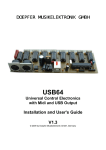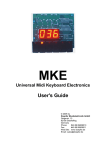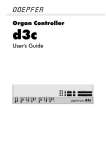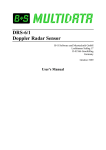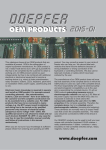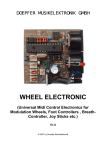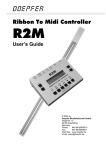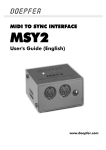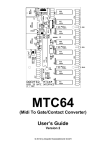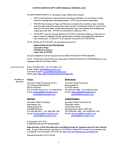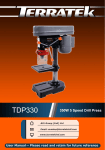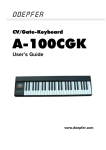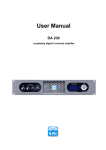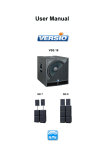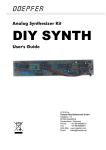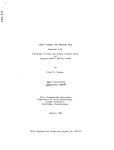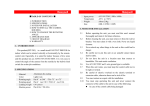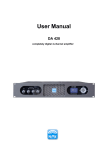Download User`s Guide
Transcript
DOEPFER Midi Bass Pedal Electronic Kit MBP25 User's Guide © 2008 by Doepfer Musikelektronik GmbH Geigerstr. 13 82166 Graefelfing Deutschland / Germany Phone: + 49 89 89809510 Fax: + 49 89 89809511 Web Site: www.doepfer.com Email: [email protected] Electrical safety / EMC compatibility MBP25 is a so-called OEM product (OEM original equipment manufacturer) that cannot be used independently but has to be combined with additional electrical or electronical equipment to become a working device (suitable keyboard, pitch bend and modulation wheel, rotary or fader potentiometer, power supply, case/housing). The manufacturer of MBP25 does not know the final assembly of the complete device in which the MBP25 is used as a part of the complete device. The final responsibility with regard to electrical safety and electromagnetic compatibility is up to the user who is assembling the complete device. Please pay attention to the following items: The power supply used in combination with the MBP25 has to be a closed type (in Germany a power supply with VDE approval is required). Normally an AC adapter with plastic case is used. It is not allowed to use open power supplies with open mains voltage access (e.g. via mains lead, pcb tracks, electronic parts). On the MBP25 electronics preventing measures against electromagnetic radiation are met (e.g. RF filters at the power supply input and the MIDI lines). But it is impossible to estimate to what extend the components added by the user affect the EMC properties of the complete assembly. Therefore the complete device has to be shielded against electromagnetic radiation (incoming and outgoing). These demands are normally met by a closed metal case that covers the complete assembly. The metal case should be connected to GND of the MBP25. Warranty • All connections have to be carried out in the off-state of the MBP25 (i.e. without power supply) • The MBP25 electronics is an electrostatic sensitive device. Avoid any electrostatic charges ! • Do not solder directly to any of the pin headers but use connectors to make the connections between the MBP25 and your application. • Applying a negative voltage or a positive voltage beyond +5V at any of the inputs will destroy the circuit. • Avoid short cuts while MBP25 is powered (e.g. caused by metallic or conducting supports) ! • Ignoring any of these items will cause warranty loss ! • Return of the MBP25 within the 2 weeks return time limit (valid only in Germany) is only possible if all these items have been met. MBP25 that have been soldered or modified by the customer cannot be taken back. Electronic basic knowledge is required to install the MBP25 electronic kit. If you are not sure whether your knowledge is sufficient please consult an expert. We cannot take back modules that became defective because of wrong installation or wrong connection of the controls or voltages. We also cannot take back modules or cables which have been soldered by the user. MBP25 Page 2 User's Guide Table of contents Electrical safety / EMC compatibility ........................................................................................2 Warranty...................................................................................................................................2 Table of contents......................................................................................................................3 Introduction...............................................................................................................................4 Connections .............................................................................................................................6 (1) Power Supply ..................................................................................................................6 (2) Midi Out ...........................................................................................................................6 (3) Midi In..............................................................................................................................6 (4) Bass Pedal Connectors...................................................................................................8 (5) Connector for Volume Control.........................................................................................8 Controls .................................................................................................................................10 1. Midi Channel ...............................................................................................................10 2. Transpose ...................................................................................................................11 3. Program Change 1......................................................................................................11 4. Mode ...........................................................................................................................11 Parameter Storage .................................................................................................................12 Configuration Mode ................................................................................................................12 Check list................................................................................................................................12 Shortening the second bass pedal .........................................................................................13 Schematics PD/3....................................................................................................................16 User's Guide page 3 MBP25 Introduction MBP25 is an electronic kit that has been developed for midi bass pedal applications. Unfortunately our supplier (Fatar) does not offer bass pedals with 25 or more keys but only versions with 13 or 17 keys. As many customers have been asking for a basspedal with 25 keys we decided to develop an electronic kit that can be used to connect two bass pedals with 13 keys each (Fatar PD/3) to obtain a 25 key bass pedal in a very economic way. Of course MBP25 can be used also in combination with one PD/3 only. The picture below shows one possibility how two PD/3 pedals can be combined to a 25 key pedal and built into a black varnished wooden case (the electronics is not to be seen). The construction is made of two 13 keys pedals PD/3 and the MBP25 electronic kit. One of the two pedals has to be shortended by one key as one of the "C" keys is redundant. Fortunately the PD/3 pedals use a plastic frame and can be shortened with passable effort. In this user's manual the shortening and wiring of the two bass pedals is described later. A bit mechanical skills and suitable tools are required (soldering iron, saw, screwdriver). Both pedals can be mounted on a common base plate and covered by a suitable case (e.g. made of varnished wood - as shown above) can be added. The base plate and the case are not included and have to be added by the customer. We do not offer these parts. The MBP25 electronic kit is already prepared to connect a third pedal so that even bass pedals with up to 36 keys are possible (in this case the upper "C" of two pedals has to be removed). For this version a special cable has to be used that leads to the second and third pedal. In addition a rotary or slider potentiometer can be connected to transmit midi volume data (midi control change #7). MBP25 is available only as an assembled and tested pc board. The pc board measures are about 82 mm (length) x 73 (width) x 25 mm (height). Four mounting holes with 3 mm diameter are available for mounting the pc board to a suitable base or front panel e.g. with distance sleeves or spacers and screws. Remark: All basspedals manufactured by Fatar that include velocity are equipped with solid steel frames and cannot be shortened in such an easy way. In addition the connectors of PD/3 and PD/2A are not compatible. MBP25 Page 4 User's Guide These are the most important features of the MBP25: • • • • • • • • • • • • • • • • three versions available: • elektronic kit only • elektronic kit with one 13-key bass pedal and connection cable • elektronic kit with two 13-key bass pedals and connection cables 6 black rectangle momentary buttons (about 12 x 22 mm) with integrated LEDs to adjust the parameters (e.g. Midi channel, transpose, mode), measures of the complete button area about 76 x 22 mm 3-digit LED display (about 19 x 38 mm) for parameter display two connectors for basspedals (compatible to Fatar PD/3) fully polyphonic midi out midi channel 1...16 transposition in six octave intervals (lowest key = midi note number 0, 12, 24, 36, 48, 60) Midi In, Midi Out (connected via 30 cm long cables to enable the mounting of the sockets at the desired position) The data appearing at the Midi in are merged to the data generated by the MBP25. Consequently the MBP25 can be connected to a Midi keyboard to add the basspedal data to the keyboard data. power supply socket on board, in addition a 2-pin connector is available to connect another power supply socket near the Midi sockets a 3-pin connector is available to connect a rotary or fader potentiometer that transmits Midi volume, even a foot controller (e.g. FP5) can be connected. Operating modes: • Note mode: this is the usual play mode. The bass pedal keys are used to transmit Midi note on/off message on the desired Midi channel and transposition. The velocity value is fixed and can be set by the user. • Program change mode 1: in this mode the up/down buttons are used to transmit midi program change messages while the keys of the bass pedal can be used to play in the usual way • Program change mode 2: in this mode the bass pedal keys are used to transmit Midi program change messages, the first 10 keys ("C" to "A") correspond to the numbers 0 to 9 like a pocket calculator, the selected number is shown in the display. The "Bb" key has delete function (i.e. set to zero) and the "B" key transmits the currently displayed program change number (enter function). In this mode the bass pedal keys cannot be used to play (i.e. they do not transmit note messages) • Realtime mode: in this mode the keys "C", "D" and "E" are used to transmit the midi messages start, continue and stop, the other keys have normal function (i.e. they transmit midi note messages). An external power supply (7-12VDC@min. 250mA) is used. Within Europe the wall outlet power supply adapter for 230V mains voltage and European type mains plug is included with the MBP25. In other countries the power supply has to be purchased by the user in his country. If there is a Doepfer representative or dealer in your country please ask the representative or dealer if the power supply is included in your country. Dimensions of the pc board: about 82 mm (length) x 73 (width) x 25 mm (height) Dimension of one bass pedal: about 530 mm (length) x 380 mm (depth) x 95 mm (height) Dimension of two bass pedals: about 980 mm (length) x 380 mm (depth) x 95 mm (height) User's Guide page 5 MBP25 Connections Please refer to the picture on the next page. (1) Power Supply The MBP25 does not have a built-in power supply. Instead it uses a plug-in type external power supply (AC adapter). One reason for this feature is electrical safety. Keeping danger voltages (main) out of the MBP25 increases the electrical safety. Therefore an external power supply of high quality and safety should be used. If the device is used in Germany the external power supply has to be VDE approved. Another reason for the external power supply is the fact that line voltages and plug types vary considerably from country to country. Using a plug-in external supply the MBP25 can be used anywhere with a locally purchased power supply, thus keeping the retail price down. The power supply must be able to deliver 7-12 V stabilized or unstabilized DC voltage, as well as a minimum current of 250mA. The MBP25 is switched ON by plugging the AC adapter into a wall outlet and connecting it to the appropriate jack on the MBP25 board. There is no separate ON/OFF switch. If the polarity of the power supply is incorrect, the MBP25 will not function. However, there is no danger of damage to the circuitry since it is protected by a diode. The correct polarity is: outside ring = GND, inside lead = +7...12V. The power supply not included with the MBP25 and has to be purchased separately. After power on the six LEDs light up for a short moment and the software version (e.g. 100 for version 1.00) is displayed. After a while the operating mode is displayed (note or program change or real time, see below mode). (2) Midi Out Connect the midi out jack with midi In of the device to be controlled by the MBP25 (e.g. sound expander, computer, sequencer, synthesizer) via a suitable midi cable. (3) Midi In The MBP25 features a midi input. This input may be connected to another midi device. The incoming midi data are merged to the data generated by the MBP25. At the first place the midi input is used for the combination of the MBP25 with a midi keyboard (e.g. MKE, CTM64 or another midi keyboard). The midi input of MBP25 is not suitable for large amounts of Midi (e.g. SysEx strings or Midi messages coming from an computer sequencer). In case of large amounts of incoming Midi messages data loss or delay may occur. But for midi keyboards the data rate of the MBP25 midi input is sufficient. If the merge feature of the MBP25 is not required the Midi input is left open. MBP25 Page 6 User's Guide feedback terminal for optional third pedal (MK4) (4) bass pedal connectors ST1 (lower) and ST2 (upper) (5) connector for volume control (ST3) (2) midi out (BU1) (3) midi in (BU2) alternative alternative connector for midi connector for midi out socket in socket (JP4) (JP3) (1) power supply 7-12V/100mA DC (BU3) alternative connector for power supply (JP2) trimming potentiometer for voltage range adjustment of the volume control connected to ST3 User's Guide page 7 MBP25 (4) Bass Pedal Connectors These female connectors are used to connect the bass pedal(s). The connectors are compatible to the connectors of the Fatar PD/3 bass pedals and the same type of connectors are used (AMP micromatch 16 pins). To connect MBP25 with the bass pedal(s) 16 pin ribbon cables with a 16 pin male connector on each end is used. The connectors are equipped with code pins that have to fit into the corresponding hole on the MBP25 and PD/3 pc boards. Otherwise the pin may break off. Please check the correct polarity of the code pin before you put up the connector. If the connector is put up in the wrong way the bass pedal will not work but there is no risk to damage the electronics. If only one PD/3 bass pedal is used it is connected to ST1/LOWER. If two PD/3 bass pedals are used the lower is connected to ST1/LOWER and the upper to ST2/UPPER. If the pc board is mounted to a front panel the ribbon cable connected to ST2/UPPER has to be bended by 90 degrees to lead the cable lateral from the display. It is possible to connect even a third bass pedal to the MBP25 electronics. In this case a special ribbon cable with three male connectors has to be used that leads from ST2/UPPER to two bass pedals. In addition the feedback line of the third pedal has to be wired manually to the solder pin labelled JP1/MK4. If you want to connect a third pedal please contact us concerning this special cable and wiring as we do not offer a package with 3 pedals (use the email address [email protected]). If you want to use the MBP25 not in combination with the Fatar bass pedal PD/3 but with another bass pedal (or even single contacts or switches) the contacts have to be wired as a diode matrix. You find the corresponding schematics at the end of this manual. (5) Connector for Volume Control Remark: In the following the terms GND (= abbreviation of ground) and 0V (zero volts) are used synonymous. The pin header ST3 with three pins is used to connect the volume control. The pins of the connector have these functions: Position Function To be connected to ... end terminal #1 of the potentiometer (the terminal that corresponds to Midi data 0) left GND center measuring input (control voltage) center terminal of the potentiometer right +5V end terminal #2 of the potentiometer (the terminal that corresponds to Midi data 127) The wires leading to the potentiometer can be soldered directly to the pins of ST3. But it's also possible to use a prepared standard 3-pin female connector with cable. As the potentiometer is used as a voltage divider between GND and +5V the resistance value of the potentiometer is not crucial. Any value between about 5k and 500k (linear) will work. MBP25 Page 8 User's Guide The potentiometer connected to ST3 generates midi volume data (control change #7). If no potentiometer is connected to ST3 the center pin has to be connected to +5V. For this ST3 is equipped with a jumper in the factory. An open center pin of ST3 will cause the transmission of random midi volume data ! By means of a trimming potentiometer the maximal voltage value for the potentiometer connected to ST3 can be adjusted in a range of about +3.5V...+5V. This value corresponds to midi data 127. This feature is useful if a potentiometer is used which does not cover the whole rotating angle. This applies e.g. for some foot controllers (e.g. Fatar FP5). In this case not the full midi data range 0...127 would be covered without this feature. The factory setting is +5V. In this case the trimming potentiometer is adjusted fully clockwise. If a potentiometer is connected to ST3 that covers the full rotating angle this setting remains unchanged. A normal rotating potentiometer with knob or a slider/fader potentiometer meets these requirements. If a potentiometer is connected to ST3 that does not cover the full rotating angle (e.g. the foot controller FP5) the trimming potentiometer has to be adjusted. This is the adjustment procedure: • • turn the potentiometer connected to ST3 to it's maximum position turn the trimming potentiometer beginning with the fully clockwise position until the max. midi data (127) is transmitted. If the midi volume data cannot be measured the adjustment can be done by ear too: turn the trimming potentiometer until the max. loudness is reached. If the trimming potentiometer is adjusted too far the volume function will no longer work. Only about 30% of the adjustment angle (beginning from fully clockwise) are allowed. The trimming potentiometer is connected to GND and +5V and the adjustable voltage range has to be +3.5 ... +5V. Values less than 3.5V are not allowed as the reference voltage of the ADC used (analog-to-digital converter) has to be in the range +3.5 ... +5V. Otherwise the ADC will not work correctly. User's Guide page 9 MBP25 Controls The three-digit display is used to show the value of the currently selected parameter, i.e. midi channel, transpose, program change number or mode. The LEDs indicate the currently selected menu. The four left buttons are used to select one of the four menus. The two right buttons are used to decrease or increase the value of the currently selected parameter. In addition each menu button can be used to increment the parameter of the menu in question. E.g. if the program change menu is selected the program change menu button can be used to increase the program change number too and has the same function as the UP button. The four left buttons are assigned to these menus or functions (from left to right): 1. Midi Channel In this menu the desired midi channel 1...16 is selected in combination with the up/down buttons. To avoid midi note hang ups the channel can be changed only if no key is pressed on the pedal. Otherwise the note off message would be sent on a different midi channel causing a never ending tone. The midi channel is valid for all messages generated by MBP25 (i.e. note on/off, program change, volume). MBP25 Page 10 User's Guide 2. Transpose In this menu the midi note number assigned to the lowest key on the lower pedal is adjusted in octave intervals. The value (0,12,24,36,48 and 60) is displayed and can be changed with the up/down buttons. The lowest note key is always a "C". Only the octave of the "C" can be changed. To avoid midi note hang ups the transpose can be changed only if no key is pressed on the pedal. Otherwise the note off message would be sent on a different note number causing a never ending tone. 3. Program Change 1 This menu is used to transmit midi program change messages. The present program change number is displayed and can be changed with the up/down buttons. If this menu is called up the displayed program change number is sent out via midi – even without operating the up/down buttons. The reason for this feature is that the displayed program change number should correspond to the active program change number of the midi device controlled by the MBP25 (e.g. after power on). In Program Change mode 1 one can play in the normal way with the keys of the bass pedal, i.e. they transmit midi note on/off data. 4. Mode This menu is used to select one of the three basic modes of the MBP25: • • • Note mode Program Change mode 2 Real Time mode The Note mode is the usual play mode. When this mode is selected the display shows "not" and the bass pedal keys are used to transmit Midi note on/off messages. The Midi channel selected in menue 1 and transposition selected in menu 2 are used for the note messages. The velocity value is fixed but can be set by the user in a special configuration mode (see below) . In the Program Change mode 2 the bass pedal keys are used to transmit midi program change messages. When this mode is selected the display shows "Prg" and the first ten keys of the bass pedal ("C" to "A") correspond to the numbers 0 to 9 like a pocket calculator. The currently selected number is shown in the display. The "Bb" key has delete function (i.e. it sets the value to zero) and the "B" key transmits the currently displayed program change number (enter function). In this program change mode 2 the bass pedal keys cannot be used to play, i.e. they do not transmit note messages. They are only used to generate program change messages. In the Real time mode three of the bass pedal keys are used to transmit midi real time program change messages. When this mode is selected the display shows "rtI" and the keys "C", "D" and "E" are used to transmit the midi messages start, continue and stop. All other keys have normal function (i.e. they transmit midi note messages). User's Guide page 11 MBP25 Parameter Storage Whenever one changes from one menu to another the parameter of the preceeding menu is stored non-volatile in the MBP25 memory. After the next power on these values are chosen. These values are stored: midi channel, transpose, program change number and mode. Configuration Mode In this special mode all parameters can be adjusted that have basic functions and are normally adjusted once only. So far only the velocity value for the note messages transmitted by the MBP25 can be adjusted in this mode. To select the configuration mode one has to operate one of the menu buttons during power on. Then the display shows "CoF" (abbreviation of "configuration") instead of the software version number and the 6 LEDs work inverted, i.e. all LEDs light up except the LED of the currently selected menu. The most left button (midi channel menu in normal operation) is used to adjust the fixed velocity value in the range 1...127 in combination with the up/down buttons. The remaining 3 menu buttons have no function. When the desired velocity value is set the MBP25 has to be turned off. After about 10 seconds it has to be powered again without operating one of the buttons. Now the normal operation mode is called up (the display shows the software version and then the mode). Check list In case that your MBP25 does not work at the first go please check the following points: • Is the power supply working correctly ? After power on the LEDs has to light up for a short time, the display has to show the software version (e.g. "100") and then to show the mode ("not", "Prg" or "rtI"). Otherwise the AC adapter used is not suitable, has the wrong polarity or does not work. The correct polarity is: outside ring = GND, inside lead = +7...12V. • Are the midi connections between MBP25 and the other midi devices installed correctly ? Midi out of the MBP25 has to be connected to midi in of the device controlled by MBP25. Especially when computers are used midi in and out are very often mixed up by the user. • Please use only cables that are suitable for Midi. • If all that is correct but playing on the bass pedal seems not to generate midi messages check if the pedal(s) are connected in the right way and if the midi channel of the MBP25 corresponds to the midi channel of the receiver. • If you use another bass pedal than the Fatar PD/3 (e.g. if you have built your own bass pedal or switch matrix) double check if your matrix and the connectors is identically to the Fatar keyboards. • If a potentiometer is used check if it is connected in the right way to the MBP25. An unused input (ST3) has to be terminated with a jumper ! • If the potentiometer works inverted it is connected in the wrong way (GND and +5V mixed up). • Check also if a sufficient fixed velocity value has been set (e.g. you will hear nothing with velocity 1 or 2). MBP25 Page 12 User's Guide Shortening the second bass pedal If a 25 keys bass pedal has to be made by the combination of two 13 keys pedals one of the two pedals has to be shortended as one of the "C" keys is redundant. Fortunately the PD/3 pedals use a plastic frame and can be shortened with passable effort. From our experience it's easier to remove the upper key of the lower pedal though it would be possible too to remove the lower key of the upper pedal. In the following the shortening procedure is described. Mark a cutting line with a distance of about 32-34 mm from the pcb edge to the bottom of the pcb. Cut off the pcb at his line with a suitable saw. Pay attention not to damage the red 16 pin connector on the other side of the pcb. ~ 32 mm User's Guide page 13 Cutting the pcb interrupts three tracks. They have to be repared after the cutting. These are the three (blue) connections shown in the picture. For this three wires have to be soldered across two points of the interrupted pcb tracks. It is not essential to make the connections as shown in the picture. Even longer wires can be used to connect the interrupted tracks on any two points. If existing solder points are used it is not necessary to remove the (green) solder mask to solder the wires to the copper tracks. MBP25 Cut also the black plastic bar which holds the pedal contacts with a suitable saw. One of the screws has to be removed before. remove this screw View after the pc board and the black plastic bar are cut off Mark a cutting line with a distance of about 40-42 mm from the edge to the bottom of the pedal frame. ~ 40 – 42 mm MBP25 Page 14 User's Guide Cut off the pedal frame at this line with a suitable saw. View after the pedal frame is cut off The two bass pedals can be mounted on a common base, e.g. made of wood. On the left side the bass pedal with the removed upper key is mounted. In the rear area the pedals have to mounted about 8-10 mm higher to have sufficient lift for the vertical movement of the keys. For this a small board (about 12 cm width and 10 mm thickness) over the whole lenght can be used (about 93,5 x 12 cm for two pedals). User's Guide page 15 MBP25 Schematics PD/3 If another bass pedal or single contacts/switches are connected to the MBP25 they have to be wired identically to the PD/3. This is the pin-out of the MBP25 connectors (ST1, ST2) for the bass pedals (top view): nc nc MK0 nc T3 T2 T1 T0 code hole nc nc MK1 nc T7 T6 T5 T4 Doepfer Musikelektronik www.doepfer.com MBP25 Page 16 User's Guide
















